-
50 sena anniversarju mill-promulgazzjoni tad-Digriet konċiljari, Inter Mirifica
-
An important page in the history of the Church was written fifty years ago this coming December, as the images stored in this Vatican Film Library clip show.
December 4, 1963 marked a milestone in the relationship between the Church and the media. On that day, at the closing session of the second period of the Second Vatican Council, the Fathers voted on and approved the “Decree on the Media of Social Communications, Inter Mirifica”.
As footage from the Film Library shows, the Decree was favourably received when Bishop Pericle Felice, the Secretary of the Council, submitted it to the Council Fathers for final approval. In all, it took only 12 minutes to be adopted with 1,960 votes in favour and 164 against. [The soundtrack accompanying the footage is taken from the Gospel canticle for Morning Prayer, Benedictus, which looks forward to the dawning of a new day. December 4, 1963 was certainly a new day with regard to the Church and the media.]
A milestone truly had been reached, for this was the first time the Church had defined what it understood ‘social communications’ to mean. For an Ecumenical Council to speak of Social Communications as tools for the fundamental mission of the Church was indeed timely in that it madepossiblea relatively unhindered implementation of these tools of evangelisation – in the service of the Church – with which to proclaim the Gospel, the Good News, in a rapidly-expanding and rapidly-diversifying world of mass-media. From this moment on, social communications officially became part of the Catholic Church’s programme of outreach and teaching.
The following year, on April 2, 1964, Pope Paul VI issued the Motu Proprio, In Fructibus multis, which not only changed the name of what was then the “Pontifical Commission for Cinematography,” tothe “Pontifical Commission for Social Communications” but, at the request of the Council Fathers, he entrusted this Commission with the authority and expertise regarding all methods of communication, including the responsibility of working with the press.
The prestige of the Pontifical Commission continued to grow, so much so that from 1967 onwards, the Sunday after the Ascension has been observed as the “World Day of Social Communications.” An important aspect of this day is the special message on the various aspects of social communications, which the Pope offersto both the Church and the world.
Some fifty years later, Inter Mirifica is still considered an important document for the Church’s mission; whilst not disregarding that it was a document of its time and thus posses weaknesses, which subsequent documents will address. It is, nonetheless, a recognition of the new “wonders” of the age, which have resulted from human genius, a gift of God to humanity, which can be used both for good and ill. As such, its cautionary note is still valid.The path that led to the Decree
In June 1959, Pope John XXIII requested that an initial process of consultation be commenced, which would consider various topics beingdiscussed in Council. The means of social communications was one such topic and was looked at in a very practical manner. In all, 9,348 proposals were offered for discussion, out of which 18 were released to the media.
On June 5 , 1960, with the Motu Proprio, Superno Dei Nutu, John XXIII established the Preparatory Commissions for the Council. The Commission which had responsibility for the text on communication began work in July of that same year, presided over by Archbishop Martin O’Connor, with Mons. Andrea M. Deskur as secretary.
Between 1960 and 1962, the Commission was to prepare a schema consisting of 114 paragraphs, all of which received the approval of Pope John XXIII, and thus formed a document which was subsequently included within the Acts of the Council. This text was then discussed by the Council Fathers towards the end of the First Session of the Council. On November 27, following deliberations, the President of the Council approved the document, whilst suggesting that the pastoral guidelines should be revisited later and entrusting the task to the Vatican Commission for Social Communications. This proposal was heartily approved with 2,138 Fathers voting in favour, only 15 against, and 7 abstentions. With a reduction in the text from 114 paragraphs to 24, it then qualified as a Conciliar Decree rather than a Constitution.
However, before the final vote in 1963, the document received criticism: there was concern that it was lacking from a theological point of view and was thus unworthy of being a Conciliar Document. The vote on November 25, 1963 expressed this concern, as it garnered the highest number of negative votes of any proposed Conciliar Document: 503 votes against, with 1,598 in favour and 11 abstentions. Nevertheless, in the final vote on December 4, and in the presence of Pope Paul VI, this negative reaction had diminished to 164 votes against. Thus, the decree was approved.Source: http://www.intermirifica50.va/




